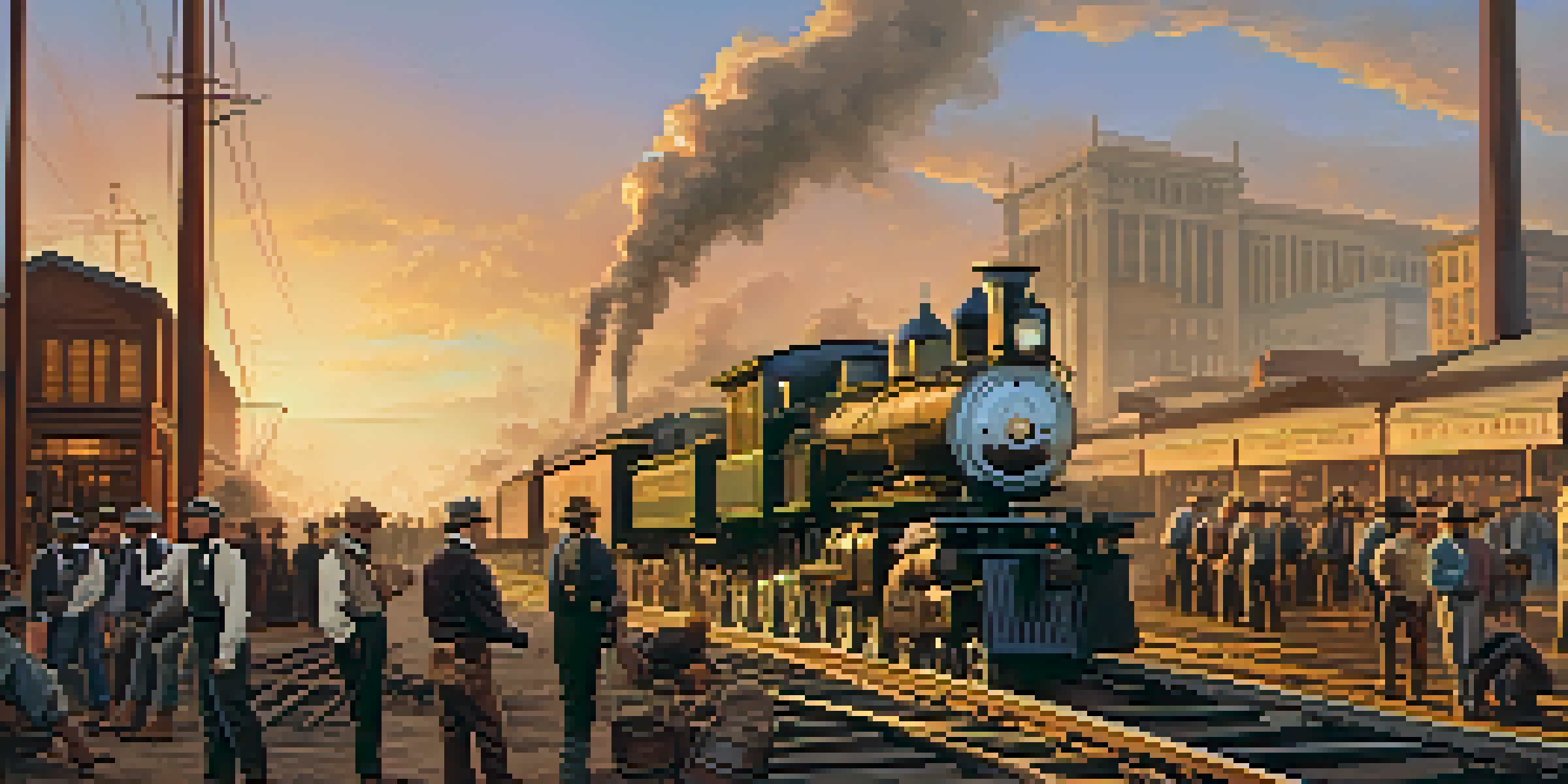Key Figures in Sacramento's Railroad Development History

The Founding of Sacramento's First Railroad
In the mid-19th century, Sacramento emerged as a pivotal hub for railroads in California. The Central Pacific Railroad played a crucial role in connecting the East and West, igniting the region's economic development. This foundational project not only facilitated trade but also attracted settlers eager for new opportunities.
The railroad is a great equalizer; it brings us all together, no matter our background or where we come from.
Key figures like Theodore Judah, a visionary engineer, were instrumental in spearheading the construction of the Central Pacific. Judah's relentless advocacy for a transcontinental railroad laid the groundwork for future expansions. His innovative ideas and tenacity helped overcome various challenges, from rugged terrain to financial hurdles.
By the completion of the railroad in 1869, Sacramento had established itself as a vital transportation center. The city became a melting pot of cultures and commerce, thanks to the influx of goods and people. This initial success set the stage for further developments in the railroad industry, deeply embedding it in Sacramento's identity.
The Role of Leland Stanford in Railroad Expansion
Leland Stanford, one of the 'Big Four' of the Central Pacific Railroad, significantly shaped the landscape of Sacramento's railroads. As a businessman and politician, he understood the importance of a robust transportation network for California's growth. His vision extended beyond railroads, influencing everything from agriculture to education.

Stanford's leadership helped secure funding and support for expanding the railroad system, allowing for connections to major cities and ports. His dedication to improving infrastructure facilitated economic prosperity in the region. Additionally, he played a pivotal role in integrating the railroad with Sacramento's burgeoning economy.
Sacramento's Railroad Economic Boom
The establishment of the Central Pacific Railroad transformed Sacramento into a vital transportation hub, driving economic growth and attracting settlers.
His legacy is not just in the railroads but also in institutions like Stanford University, which further highlights his commitment to education and innovation. By fostering a culture of progress, Leland Stanford's impact on Sacramento's railroad history is both profound and enduring.
Railroad Tycoon Collis Potter Huntington's Influence
Collis Potter Huntington, another member of the 'Big Four,' was a formidable force in railroad development during the late 19th century. His strategic vision and relentless pursuit of growth made him a key player in the expansion of the Central Pacific Railroad. Huntington's influence extended far beyond Sacramento, impacting the entire western United States.
Railroads are the arteries of commerce and the veins of civilization.
Huntington advocated for innovative technologies that improved efficiency in railroad operations. His foresight in adopting steam locomotives and extending rail lines helped Sacramento thrive as a shipping and trade center. These advancements not only benefitted the railroad but also stimulated local industries and commerce.
However, Huntington's legacy is not without controversy, as his business practices sometimes drew criticism. Despite this, his contributions to railroad development are undeniable, as he helped solidify Sacramento's status as a transportation hub in the 19th century.
The Impact of the Transcontinental Railroad
The completion of the Transcontinental Railroad in 1869 marked a transformative moment for Sacramento and its surrounding areas. This monumental achievement connected California to the rest of the United States, revolutionizing trade and travel. Sacramento became a gateway for goods heading east and settlers moving west, drastically changing the region's demographics.
The railroad's arrival led to a population boom in Sacramento, as businesses flourished and new opportunities emerged. With increased access to markets, local entrepreneurs capitalized on the influx of people and goods. This economic vitality also fostered a sense of community, as diverse cultures converged in the city.
Key Figures Shaping Railroad Expansion
Leland Stanford and Collis Potter Huntington played crucial roles in advancing Sacramento's railroad infrastructure, influencing the region's development.
Moreover, the Transcontinental Railroad was crucial in shaping the identity of Sacramento. It not only boosted the economy but also created a sense of unity among Californians, as they embraced the possibilities that came with connectivity. This pivotal event laid the groundwork for Sacramento's continued growth and development.
Women in Sacramento's Railroad History
While much of the railroad narrative focuses on male figures, women played a vital role in Sacramento's railroad history. Women like Mary Elizabeth Lease became advocates for labor rights, promoting fair wages and working conditions for railroad workers. Their contributions often went unrecognized, yet they were instrumental in shaping the workforce dynamics.
Additionally, women contributed to the social fabric of the railroad community. They established support networks for families affected by the demanding nature of railroad work. These networks provided essential services and fostered a sense of belonging among workers and their families.
The impact of women in this sector exemplifies the importance of inclusivity in historical narratives. By acknowledging their efforts, we gain a more comprehensive understanding of Sacramento's railroad history and its development.
Modern Developments: Railroads in the 21st Century
As we move into the 21st century, Sacramento's railroad system continues to evolve, adapting to new technologies and societal needs. With the rise of environmental concerns, there is a growing emphasis on sustainable transportation methods. This shift is reflected in initiatives to improve public transit and reduce reliance on personal vehicles.
The integration of light rail systems has enhanced connectivity within Sacramento, making it easier for residents to access various parts of the city. This modern approach not only alleviates traffic congestion but also promotes eco-friendly commuting options. The focus on public transportation reflects a broader trend toward sustainability in urban planning.
Cultural Impact of Railroads
The railroads have significantly influenced Sacramento's culture, inspiring art, literature, and community events that celebrate its rich history.
Moreover, the city is exploring innovative ways to revitalize old rail lines for new uses, such as bike paths and pedestrian walkways. These developments honor Sacramento's rich railroad history while promoting a future that prioritizes accessibility and environmental stewardship.
The Cultural Legacy of Sacramento's Railroads
The cultural impact of Sacramento's railroads is profound, influencing art, literature, and community identity. From historical novels to modern films, the railroad has served as a backdrop for storytelling, symbolizing adventure and exploration. This rich narrative continues to inspire artists and writers, celebrating the spirit of the frontier.
Local events and festivals often pay homage to the railroad's heritage, attracting visitors and fostering community pride. These celebrations highlight the importance of railroads in shaping Sacramento's history and its diverse population. The cultural legacy serves as a reminder of the resilience and innovation that characterized the railroad era.

Furthermore, museums and historical societies preserve artifacts and stories related to this vibrant history. By educating future generations, they ensure that the legacy of Sacramento's railroads remains alive, encouraging a deeper appreciation for the past and its influence on the present.